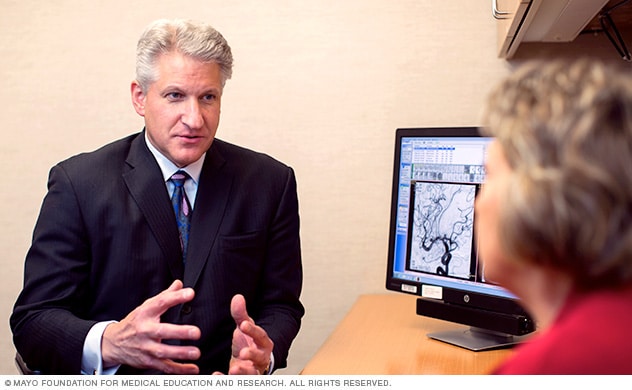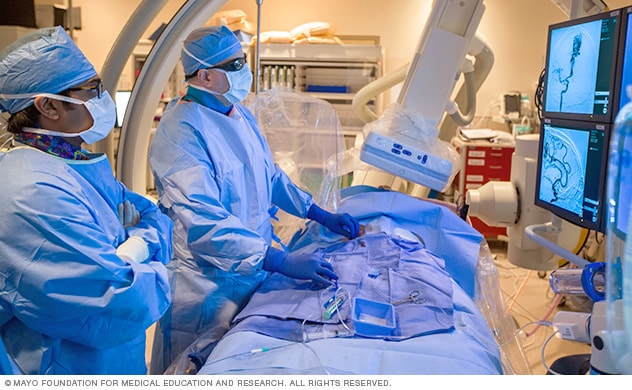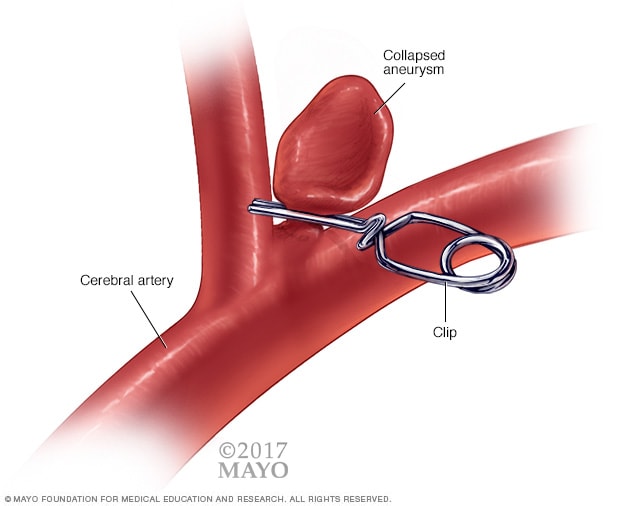Diagnosis
A sudden, severe headache or other symptoms that could be related to a ruptured aneurysm require testing. Tests can determine whether you've had bleeding into the space between your brain and surrounding tissues. This type of bleeding is known as subarachnoid hemorrhage. The tests also can determine if you've had another type of stroke.
You also may be given tests if you show symptoms of an unruptured brain aneurysm. These symptoms may include pain behind the eye, changes in vision or double vision.
Screening tests and procedures used to diagnose and detect brain aneurysms include:
-
CT scan. This specialized X-ray is usually the first test used to detect bleeding in the brain or another type of stroke. The test produces images that are 2D slices of the brain.
A CT angiogram can create more-detailed images of the arteries providing blood flow in the brain. The test involves injecting dye that makes it easier to observe blood flow. It also can detect the presence of an aneurysm.
-
Lumbar puncture, known as a spinal tap. If you've had a subarachnoid hemorrhage, there will most likely be red blood cells in the fluid surrounding your brain and spine. This fluid is called cerebrospinal fluid. If you have symptoms of a ruptured aneurysm but a CT scan doesn't show evidence of bleeding, a test of your cerebrospinal fluid can help make a diagnosis.
The procedure to draw cerebrospinal fluid from your back with a needle is called a lumbar puncture.
-
MRI. This imaging test uses a magnetic field and radio waves to create detailed images of the brain, either 2D images or 3D images. The images can show if there's bleeding in the brain.
A type of MRI that captures images of the arteries in detail is called MR angiography. This type of MRI can detect the size, shape and location of an unruptured aneurysm.
-
Cerebral angiogram. During this procedure, a thin, flexible tube called a catheter is used. The catheter is inserted into a large artery, usually in the groin or the wrist. The catheter threads past your heart to the arteries in your brain. A special dye injected into the catheter travels to arteries throughout your brain.
A series of X-rays can then reveal details about the conditions of your arteries and detect an aneurysm. A cerebral angiogram — also called a cerebral arteriogram — is usually used when other diagnostic tests don't provide enough information.
 Consultation
Consultation
A doctor shares information about brain aneurysm diagnosis.
Screening for brain aneurysms
The use of imaging tests to screen for unruptured brain aneurysms is generally not recommended unless you're at high risk. Talk to your health care provider about the potential benefit of a screening test if you have:
- A family history of brain aneurysms. Particularly if two first-degree relatives — your parents, siblings or children — have had brain aneurysms.
- A disorder that increases your risk of developing a brain aneurysm. These disorders include polycystic kidney disease, coarctation of the aorta or Ehlers-Danlos syndrome, among others.
Most aneurysms don't rupture. And for many people, an unruptured aneurysm never causes symptoms. But if the aneurysm ruptures, several factors may affect the outcome, which is known as the prognosis. They include:
- The person's age and health.
- Whether the person has other conditions.
- The size and location of the aneurysm.
- How much bleeding occurred.
- How much time passed before receiving medical care.
About 25% of people who experience a ruptured aneurysm die within 24 hours. Another 25% have complications that lead to death within six months.
More Information
Treatment
Repairing a ruptured aneurysm requires surgery or endovascular treatment. Endovascular treatment means an aneurysm is treated from inside the artery. You also may be given treatments to relieve symptoms. If you have an unruptured aneurysm, talk with your health care provider about possible treatments. Discuss whether the risk of leaving the aneurysm alone is greater than the risk of treating the aneurysm.
Surgery
 Brain aneurysm treatment
Brain aneurysm treatment
Mayo Clinic surgeons perform an endovascular procedure for brain aneurysm.
There are two common treatment options for repairing a ruptured brain aneurysm. In some cases, these procedures may be considered to treat an unruptured aneurysm. However, the known risks may outweigh the potential benefits for people with some unruptured aneurysms.
Aneurysm clip

Aneurysm clip
A surgical procedure to treat brain aneurysms involves opening the skull, finding the affected artery and then placing a metal clip over the neck of the aneurysm.
Surgical clipping
Surgical clipping is a procedure to close off an aneurysm. The neurosurgeon removes a section of your skull to access the aneurysm. The neurosurgeon then locates the blood vessel that feeds the aneurysm. The surgeon places a tiny metal clip on the neck of the aneurysm to stop blood flow into it.
Surgical clipping can be very effective. Typically, aneurysms that are clipped don't return. The risks of surgical clipping include bleeding in the brain or loss of blood flow to the brain. These risks are low.
Recovery from surgical clipping usually takes about 4 to 6 weeks. When surgical clipping is done for an unruptured aneurysm, many people can leave the hospital a day or two after surgery. For those who undergo surgical clipping because of a ruptured aneurysm, the hospital stay is typically much longer as they recover from the aneurysm rupture.
Endovascular coiling

Endovascular coiling
With endovascular coiling, the surgeon feeds a soft, flexible wire into the aneurysm via a catheter. The wire coils inside the aneurysm and seals off the aneurysm from the artery.
Endovascular treatment
This is a less invasive procedure than surgical clipping, and it may be safer. Endovascular treatment involves accessing the aneurysm by threading a small plastic tube called a catheter through the artery. The catheter is advanced into the brain arteries. Then coils or stents may be placed.
- Endovascular coils. During this procedure, a neurosurgeon inserts the catheter into an artery, usually in the wrist or groin. Then the surgeon threads it through the body to the aneurysm. A coil shaped like a spiral is placed inside the aneurysm. This prevents blood from flowing into the aneurysm. The coil also causes the blood that's in the aneurysm to clot. This destroys the aneurysm.
- Endovascular stents. A stent is a small tube that may be used with an endovascular coil for some types of brain aneurysms. A stent can hold the coil in place.
Other endovascular methods may be used depending on the location and size of the aneurysm.
Like surgical clipping, endovascular treatment carries the risk of bleeding in the brain or loss of blood flow to the brain. Also there's a risk that the aneurysm may again appear over time. If that happens, the procedure needs to be repeated. You'll likely need follow-up imaging tests to be sure the aneurysm hasn't returned.
Flow diversion
Flow diversion is a newer endovascular treatment option for treatment of a brain aneurysm. The procedure involves placing a stent in the blood vessel to divert blood flow away from the aneurysm. The stent that's placed is called a flow diverter.
With less blood flow going to the aneurysm, there's less risk of rupture. It also allows the body to heal. The stent prompts the body to grow new cells that seal the aneurysm.
Flow diversion may be particularly useful in larger aneurysms that can't be treated with other options.
A neurosurgeon or interventional neuroradiologist will likely work with your neurologist to recommend treatment. Treatment is based on the size, location and overall appearance of the brain aneurysm. They also may consider factors such as your ability to undergo a procedure.
Other treatments for ruptured aneurysms
Other methods for treating ruptured brain aneurysms are aimed at relieving symptoms and managing complications.
- Pain relievers, such as acetaminophen (Tylenol, others), may be used to treat headache pain.
-
Calcium channel blockers prevent calcium from entering cells of the blood vessel walls. These medicines may lessen the risk of having symptoms from the narrowing of blood vessels, known as vasospasm. Vasospasm may be a complication of a ruptured aneurysm.
One of these medicines, nimodipine (Nymalize), has been shown to reduce the risk of delayed brain injury caused by insufficient blood flow. This can happen after subarachnoid hemorrhage from a ruptured aneurysm.
- Medicines to open blood vessels. A drug can be given to dilate the blood vessels. This can be given through an IV in the arm or with a catheter directly into the arteries supplying the brain. This can help prevent a stroke by allowing the blood to flow freely. Blood vessels also can be expanded using medicines known as a vasodilators.
- Angioplasty. This is a procedure to expand a narrowed blood vessel in the brain caused by vasospasm. The procedure also can help prevent a stroke.
- Anti-seizure medicines may be used to treat seizures related to a ruptured aneurysm. The medicines typically aren't given if a seizure hasn't occurred.
-
Ventricular or lumbar draining catheters and shunt surgery can lessen pressure on the brain from excess cerebrospinal fluid. Fluid can build up after a ruptured aneurysm. A catheter may be placed in the spaces that are filled with fluid inside the brain. Or it can be placed in the area surrounding the brain and spinal cord. The catheter drains the excess fluid into an external bag.
Sometimes a shunt system is placed. A shunt system is a flexible silicone rubber tube and a valve that creates a drainage channel. The drainage channels starts in the brain and ends in the abdominal cavity.
- Rehabilitative therapy. Damage to the brain from a subarachnoid hemorrhage may result in the need for physical, speech and occupational therapy to relearn skills.
Treating unruptured brain aneurysms
A surgical clip, an endovascular coil or a flow diverter can be used to seal off an unruptured brain aneurysm. This can help prevent a future rupture. However, the risk of rupture is extremely low in some unruptured aneurysms. In these cases, the known risks of the procedures may outweigh the potential benefits.
A neurologist working with a neurosurgeon or interventional neuroradiologist can help you determine whether surgical or endovascular treatment is appropriate for you.
Factors to consider in making treatment recommendations include:
- The aneurysm size, location and overall appearance of the aneurysm.
- Your age and general health.
- Family history of ruptured aneurysm.
- Conditions you were born with that increase the risk of a ruptured aneurysm.
If you have high blood pressure, talk to your health care provider about medicine to manage the condition. If you have a brain aneurysm, proper control of blood pressure may lower the risk of rupture.
In addition, if you smoke cigarettes, talk with your care provider about strategies to stop smoking. Cigarette smoking is a risk factor for formation, growth and rupture of the aneurysm.
Clinical trials
Explore Mayo Clinic studies testing new treatments, interventions and tests as a means to prevent, detect, treat or manage this condition.
Lifestyle and home remedies
Lifestyle changes to lower your risk
If you have an unruptured brain aneurysm, you may lower the risk of rupture by making these lifestyle changes:
- Don't smoke cigarettes. If you smoke, talk to your health care provider. Your provider can suggest strategies or a treatment program to help you quit.
- Control your blood pressure if you have high blood pressure.
- Eat a healthy diet and exercise. Changes in diet and exercise can help lower blood pressure. Talk to your health care provider about changes that are appropriate for you.
- Don't use drugs such as cocaine, methamphetamine or others. If you do use these drugs and would like to quit, talk to your provider.
Coping and support
The Brain Aneurysm Foundation offers information on connecting with support groups in many states and in other countries.
Preparing for your appointment
Brain aneurysms are often detected after they've ruptured and become medical emergencies. However, a brain aneurysm may be detected when you've undergone head-imaging tests for another condition.
If such test results indicate you have a brain aneurysm, you'll need to discuss the results with a specialist in brain and nervous system disorders. These specialists include neurologists, neurosurgeons and neuroradiologists.
What you can do
To make the best use of your time with your health care provider, you may want to prepare a list of questions, such as:
- What do you know about the size, location and overall appearance of the aneurysm?
- Do the imaging test results provide evidence of how likely it is to rupture?
- What treatment do you recommend at this time? What are the risks of treatment?
- If I wait, how often will I need to have follow-up tests?
- What steps can I take to lower the risk of an aneurysm rupturing?
What to expect from your doctor
Your neurologist, neurosurgeon or neuroradiologist may ask you the following questions to help determine the best course of action:
- Do you smoke?
- How much alcohol do you drink?
- Do you use recreational drugs?
- Are you being treated for high blood pressure?
- Do you take your medicines as prescribed by your health care provider?
- Is there a history of brain aneurysm or brain aneurysm rupture in your family?